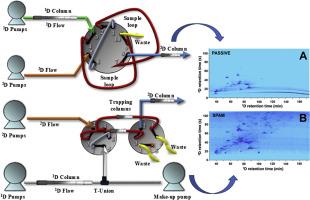Exploration of comprehensive two-dimensional liquid chromatography: Theoretical aspects and practical considerations - A tutorial
IF 3.2
引用次数: 0
Abstract
Comprehensive two-dimensional liquid chromatography (LC×LC) is a valuable tool for the analysis of very complex samples. LC×LC, which involves the coupling of two or more orthogonal separation systems, is a potential alternative to the conventional liquid-chromatography (1D-LC) approach. The profits of such a technique, compared to the 1D-LC approach, are the increased resolving power along with significant reduced ion enhancement or suppression phenomena in the MS source. This tutorial aims to provide detailed information on theoretical and practical aspects of the LC×LC approach with a particular focus on column combination, method optimization and separation performance. In addition, future perspectives and new trends are highlighted.

探索全面的二维液相色谱:理论方面和实际考虑-教程
综合二维液相色谱(LC×LC)是分析非常复杂样品的宝贵工具。LC×LC,它涉及两个或多个正交分离系统的耦合,是传统液相色谱(1D-LC)方法的潜在替代方案。与1D-LC方法相比,这种技术的优点是提高了分辨率,同时显著减少了MS源中的离子增强或抑制现象。本教程旨在提供LC×LC方法的理论和实践方面的详细信息,特别关注柱组合,方法优化和分离性能。此外,还强调了未来的前景和新趋势。
本文章由计算机程序翻译,如有差异,请以英文原文为准。
求助全文
约1分钟内获得全文
求助全文
来源期刊

Journal of chromatography open
Analytical Chemistry
CiteScore
2.50
自引率
0.00%
发文量
0
审稿时长
50 days
 求助内容:
求助内容: 应助结果提醒方式:
应助结果提醒方式:


